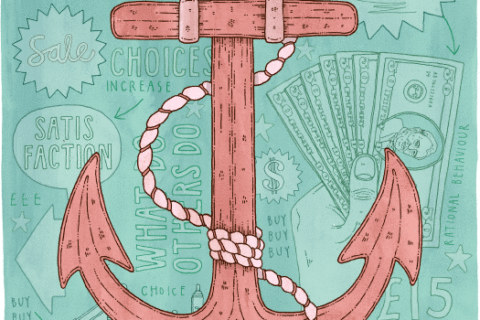Lucy Davison
As a young PR at design agency Coley Porter Bell in the 1990s I saw my first research presentation. Although nearly 20 years ago, the memory is very clear in my mind. It was delivered by a very nice woman from a leading, global research agency. The data was interesting, and there was lots of it. But the content was muddled. It went on for a very long time. There was no story, no conclusion and no recommendations. The audience was bored, frustrated and confused.
Once the presentation was over and the nice lady had left, we were quite angry. There was no way we could use the information we had been given. So, it fell to me to take the data and turn it into something we could actually use. I used my experience in journalism and worked hard over many hours to review all the data, find a clear story, and to create a compelling presentation. We then used that presentation in many different ways over the coming months – for conference presentations, media stories and to add value to our clients. It worked very well.
When, more than five years later, I started working in the research industry, I found things had not really moved on. Although the researchers I met were aware that they had a problem with how they communicated, most had not yet taken the first step to creating client materials that were motivating or had impact. Since then I have spent a great deal of my time working with researchers trying to improve the quality of what they deliver to clients. Although I have seen some great new developments, overall I have been frustrated that, although the world is moving very fast, researchers are not keeping up. We need to find new approaches to improve our outputs – and we need to find them fast.
I firmly believe that we can all become great communicators – but we need to work really hard at creating stories and bringing them to life.
There is no doubt that researchers strive to communicate well. They want to create presentations and materials that will impress clients and help ensure their work is used to drive decisions. They are all too aware of the shortcomings of long, dull PowerPoint presentations and reports that gather dust on shelves. But many clients and PR, design or ad agencies that get the results of the industry’s best efforts, say presentations and materials produced by researchers still fall far short of the mark. Andrew Doyle of Holmes & Marchant has seen a great deal of communication by researchers, both as a marketing client working at multi-national companies and now as the managing director of a brand design agency. His comment? “I have never, ever seen a good presentation from a research company in 40 years of being on the receiving end of them. And it’s getting worse.”
Jonathan Todd, head of analytics at advertising agency Wunderman comments “A research presentation always stands out. They contain a lot of information – all structured in the same way. Slide after slide of too much data. They don’t get to the point quickly enough”. Aziz Cami, founder of design agency The Partners and now creative consultant to Kantar, reiterates this point – “successful research communications are ones that create action. We have to provide materials that are motivating solutions to a business issue. Unless we make our outputs vivid, exciting and actionable, it’s just data”.
The world is changing, is research keeping up?
While researchers have been talking about how they need to improve their communications, and not making much progress, the world has changed immeasurably. We are all living in a vastly more visual world than 10 or even five years ago. The internet has given us all access to instant visual and mental gratification. There are hundreds of image sites, videos, presentations and infographics running wild in the digital world. We are all, to an extent, seduced by this. It brings out our inner two-year old and makes us demand instant answers, presented in a colourful, clear and bright way. What is more, evidence shows that the attention span of humans is decreasing as modern technology increases.
Research clients and agency researchers are all consumers operating within this new environment. We expect to be entertained. We expect simplicity. At the same time, we are facing an onslaught of communication which we struggle to deal with. There is no doubt that “we can’t notice and know everything; the cognitive limits of our brain simply won’t let us. That means we have to filter or edit what we take in” (1). Multi-tasking and excessive stimulation, combined with exhaustion, restrict what we see and do. Even really clever people can struggle with complex and abstract ideas. In addition, because researchers have been immersed in data and close to a study they have often had the time to process its complexities; they forget that their audience has not. They can see clearly – and think what they are communicating is sometimes ‘obvious’.
The power of data journalism and infographics
One way the world has changed that is particularly pertinent to researchers is the explosion of data presented visually. Some infographics have astonishing freshness and clarity. Some add nothing to the sum of human understanding. But you can see in their simplicity how appropriate they are to the impatient internet generation. Infographics are being produced by designers, journalists and visualisers such as David McCandless and Paul Bradshaw, not in the main by researchers or research agencies. But, surely researchers should be at the forefront of developing exciting new ways to communicate data and make it engaging? Is this not part of what research is all about?
No story, no point
From our very first experience of fairy tales, stories are archetypes that allow us to make sense of our world. It’s my view, that without the basic skills of storytelling, researchers are not able to create great infographics, or any great communication for that matter. Tom Ewing (Guardian journalist and Social Media expert at Brainjuicer) thinks that the story is the communication of the ‘idea’. From a research perspective, I think this is a useful distinction. The ‘story’ is not the output or result of a research project. It is the communication of the output and as such should be treated as a distinctive ‘project’ in itself. Research agencies that have adopted this approach have been able to move the presentation of data forward through their use of dramatisation, targeting and story-telling.
The true value of research lies in how much impact it has. As Lorna Walters of Reckitt Benckiser said at the last ESOMAR Congress ‘you’ve got to improve your product’ (what we actually give to clients as a result of our research studies) or in five years time management consultants and advertising or marketing agencies will have had our cake – and eaten it. Food for thought?
Lucy Davison is Managing Director at Keen as Mustard Marketing
As a communications expert, Lucy has developed a one-day workshop for ESOMAR’s Congress 2012 in Atlanta. This is built around several interactive exercises, designed to help researchers focus on how to turn their communications from dull to dynamic. Starting with the core principles of good communication, the exercises will help researchers learn how to capture insight and turn it into a compelling message in true ‘Mad Men’ style. We look at what techniques journalists use to communicate stories in a really compelling way, how to approach stories visually rather than using words or numbers and how to focus on appropriate and relevant communications for different audiences. More information on the workshop can be found on the ESOMAR event pages.
| (1) Heffernan, Margaret ‘Wilful Blindness, Why We Ignore the Obvious at Our Peril’ Simon & Schuster Ltd, Published: 3 Feb 2011 |



1 comment
An extremely good article, Lucy, and I wish you well for your workshop in Atlanta.
My favorite quote from a client, summarizing this, is: “The presentation should last 10 minutes; the conversation should go on for hours.” I.e. the 10-min presentation should encapsulate a story so powerful that its recipients move immediately on to debate its implications and how to use it in a way that will impact real decisions.